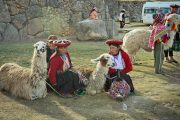In the heart of the Andes, where the mighty Inca Empire once flourished, the official language that echoed through the mountains and valleys was Quechua. As one of the most significant indigenous languages in South America, Quechua held a central role in the cultural, administrative, and communicative spheres of the Inca civilization.
Quechua, a language with various dialects, was the spoken tongue of the Inca rulers, nobility, and commoners alike. Its prominence extended beyond daily communication, encompassing religious rituals, administrative decrees, and even the recording of historical events through the unique Inca system of knotted cords known as quipu.
The Inca Empire was characterized by its linguistic homogeneity, fostering unity and facilitating governance across vast territories. Quechua served as the lingua franca, allowing for effective communication among diverse ethnic groups under Inca rule.
Despite the passage of centuries, Quechua continues to endure. Present-day descendants of the Inca civilization proudly speak and preserve this ancient language, contributing to its cultural resilience and the ongoing legacy of the once-mighty Inca Empire.
In unraveling the linguistic tapestry of the Inca Empire, Quechua emerges as more than a mere language; it embodies the cultural richness, historical continuity, and enduring spirit of a civilization that left an indelible mark on the landscape of South America.










Comment (0)